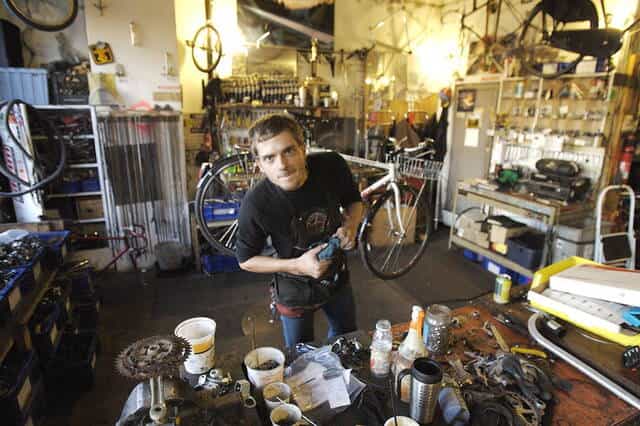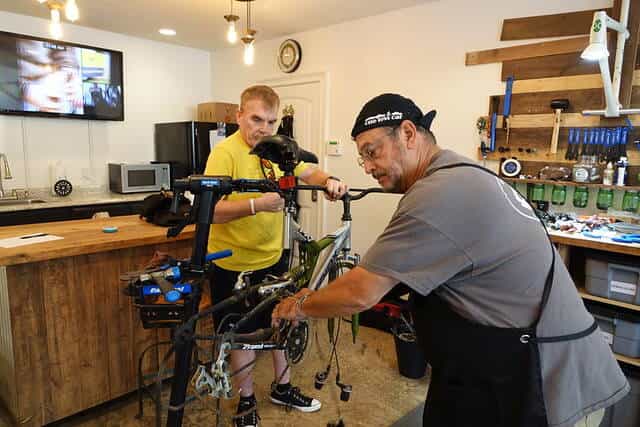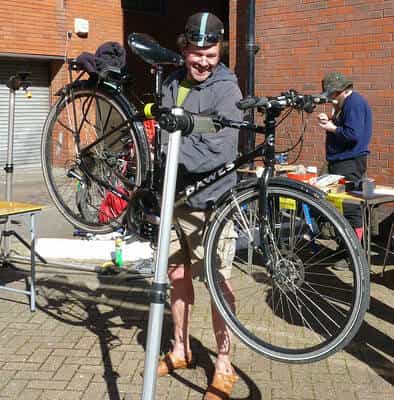The best way to keep your bike like new ( especially if you want the best performance from your bicycle ) is to give it a proper tune-up at your local bike shop.
Regular bicycle tune-up is essential whether its hybrid, road, or mountain bike. If you ride your bicycle casually, the idea of a tune-up may not have occurred to you. An avid cyclist, on the other hand, may have invested in personal equipment to perform routine maintenance at home with astounding regularity.
It’s important to note that a bicycle, while relatively simplistic in design compared to a car, is a complex machine with various components that enable it to perform optimally.
In other words, there are factors that need to be attended to beyond inflating your tires. Taking the time to have your bike serviced presents the accumulation of problems that could render it virtually unusable, inevitably incurring a high replacement cost or worse yet, a loss of interest altogether.
For those who simply want to keep their bike in its best working order, paying for a tune-up from time to time is an investment that will prove itself throughout a bike’s lifespan.
But before you load up for a quick service trip to the repair shop you must be wondering just how much does a bike tune-up cost and what it all includes?
Well I have broken down everything you need to know in most simplest terms below.
What’s The Average Cost of a Bike Tune-up?
Depending on the city, country, or state, a tune-up performed by a bike mechanic could range from around $55 for a basic, general-purpose tune-up to around $200 dollars for a complete overhaul.
This usually does not include the price of major bike components that need to be replaced. You may wish to overhaul the existing component but sometimes you need to replace it with a new one. So take a range of $25 to $200 for that. With more expensive bikes, however, come more expensive parts.
You might be able to pay the bike mechanic with the cash in your glove box for a Huffy while you might need to whip out a credit card for replacements ordered on some Specialized racing machine.
For example, my Roadmaster Granite Peak cost’s a mere $363 for a complete tune-up replacing the chain, handlebar, and derailleur. But my old Fuji road bike took almost half a grand for the job.
While you may be discouraged by the price, having your bike routinely serviced will prevent the heavy financial burden of needing to replace a bike that was neglected.
If you are an avid cyclist and demand more from your bike than the average person, you may want to consider investing in a few pieces of equipment to save some money in the long run, as well as honing your handy skills by educating yourself on some of the essential techniques for performing a tune-up yourself.
However, if you are ever in doubt about your abilities to successfully service your bike, it is a good idea to let a professional handle it for the time being to avoid causing damage.
At least until you’ve established the necessary aptitude.

How Much Can I Save Doing It Myself?
Speaking of math, you can save the service charge ( $50 to $200 ) for the bike tune-up going DIY way. But still, you may need to invest once in 2-3 years replacing parts.
The essentials for your own bike maintenance station are many of the same tools that a mechanic would use: an Allen wrench set (of various sizes), a set of open-end wrenches, a bike repair stand, chain lubricant, a chain-cleaning tool, a chain brush, a tire patch kit, several spare tubes (if you tend to push your bike hard), and a quality floor pump with a PSI gauge.
That’s a great save for avid cyclists who like to tune up their bikes regularly. Many bike shops give a special discount to their existing customers. So there is always a choice, where you may wish to do the easier ones yourself and bring it to the repair shop to make heavy changes.
With the necessary materials, along with some skill and patience, you have everything you need to keep your bike running smoothly for years to come.
Why Bike Tune-Up So Important – Why Get One?
There are a number of reason for which one may need to tune up his or her bike. This may include one’s personal choice to maintain the level of comfort, performance and maneuverability or an desperate attempt to save the bike from failing after kept idle for years.
If you have a bike that’s lying idle in garage for years and you want to ride again; at least you want it in good shape for proper use. A bike tune-up is just what you need in such a scenario.
Event when you use cycle regularly one should go for bike tune-up at least once a year. This helps escape situation likes chain slips, rusting, difficulty shifting gears, difficulty braking etc.
Even more, you may soon find your adjustable seats, handlebars and shockers aren’t adjustable anymore. Due to rust and gunk build up on your bike it will make noise.
In any of such situation you may be amazed at the difference post bike tune-up. All it needs is a through clean up, lubrication and minor repairs of parts if needed.
Unfortunately, many people don’t recognize these signals and continue riding unless one or more parts fails. This not just cost them more money on repairs but also their health, as a few cyclist always prefer to quit than to pay half a grand on their bike repairs.
So I personally prefer and suggest everyone go for a minimal bike tune-up that cost you around $50. That’s almost all you need to spend on your bike each year.

What Does a Bicycle Tune-Up Consist Of?
The parts serviced, along with the degree of service, can vary based on the service you seek.
A higher end tune-up can be more aptly called a bicycle refurbishment and may include a complete overhaul. The repairperson is likely to completely disassemble your bike, clean and polish parts individually, and replace the drivetrain if needed.
Services like this are the most expensive type of tune-up you can get but are generally cheaper than purchasing a new bike will still giving you like-new rideability when you retrieve it.
In general, however, a tune-up includes:
1. Tire Inflation
This is probably something you do on a daily to the weekly basis on your own, but this is generally included in a tune-up with everything else to ensure that your bike is rideable immediately once service is complete.
Making sure your tire pressure is correct is the simplest step to ensuring your bike is fast. It’s also one of the easiest and cheapest, as all you really need is a pressure gauge and an air pump.
Tires with low pressure create more rolling resistance, which cuts back on speed.
If you feel that your bike is running sluggish, check the tire pressure gauge before investing in new and expensive tires or taking it to the shop for repairs.
2. Brake Adjustments
There is an optimal position for the brake pads in relation to the rims to ensure that braking is as smooth and noiseless as possible. With general usage, however, brake pads are prone to shifting and being worn down. Potentially leading to squeaking and reduced brake effectiveness (a safety hazard) respectively.
During a tune-up, the bike mechanic will do a few things to ensure that your brakes are quiet and responsive.
After inspecting the brake pads to determine if they are in good shape, he or she will adjust the brake pads either up or down as needed to ensure that they are positioned to make full contact with the rim, sanding them if necessary until smooth.
Secondly, the mechanic will adjust the cables and arms to optimize tension. Alas, if your brake pads are worn down, you will probably end up paying a little bit more to have them replaced for your safety.
3. Wheel Truing
Wheel truing is, in many ways, the equivalent of a tire alignment for a car. Having untrue wheel alignment damages the tires and reduce your maximum speed.
The mechanic will place your bike upon a truing stand, a dedicated piece of equipment for rotating the wheel, and measures for deviations in alignment. If the wobble is detected, the mechanic will tighten the appropriate spokes to ensure that the wheel is straight and rigid.

4. Gear Tuning
If you’ve been riding bikes for some time, you must have been across at least one such bike where it needs extra effort just to change gears. It’s really frustrating to experience a sluggish, loose, or worn-out derailleurs when you constantly need to shift gears like in commute or mountain trails.
To ensure smooth shifting, the mechanic is going to make adjustments to the front and rear derailleurs.
The process is relatively simple, it all takes tightening or loosening the cable adjuster. The mechanic then makes sure that the derailleurs are “indexed” correctly to line up perfectly with each gear.
This will results in smooth, silent, and efficient gear shifting while also reducing the risks of a chain slip. Drivetrain adjustment is a little tricker than others that requires a quite skilled hand, but luckily its part of a basic bike tune-up that does not cost much.
5. Drivetrain Lubrication
Next to tire inflation, lubrication is one of the most common routine maintenance practices that can be done with minimal equipment.
After placing your bike on a stand and checking for any excess wear to assess if it needs replacement, the mechanic will clean the chain with a rag to rid of any unwanted grease and debris.
To get any additional grime, a dedicated device called a chain-cleaning tool (yeah, kind of a dull name) will enable the mechanic to get inside the links while simply turning the pedal.
After cleaning the crankset, derailleurs, and crevices within the cassette, the mechanic will simply add lubricant directly to your chains and spin the pedals to distribute it.
6. Cable Maintenance
Your cables need repairs too. These are tightly coiled cables with a plastic casing that degrade with time.
Your brakes and gears are controlled through cables that are activated by the switches on the handlebar. The mechanic will inspect/examine the cable for looseness, cracks, or crimps.
For best performance, these need to be routinely tightened to ensure that your gears actually shift on command and you actually stop when you brake.
Also Read,
How To Remove And Repair Bike Chain Without Special Tool









Thank you for sharing